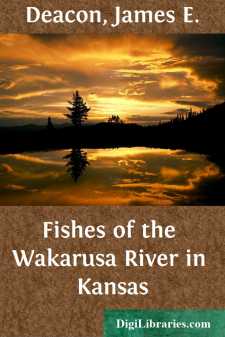Categories
- Antiques & Collectibles 13
- Architecture 36
- Art 48
- Bibles 22
- Biography & Autobiography 813
- Body, Mind & Spirit 142
- Business & Economics 28
- Children's Books 17
- Children's Fiction 14
- Computers 4
- Cooking 94
- Crafts & Hobbies 4
- Drama 346
- Education 46
- Family & Relationships 57
- Fiction 11829
- Games 19
- Gardening 17
- Health & Fitness 34
- History 1377
- House & Home 1
- Humor 147
- Juvenile Fiction 1873
- Juvenile Nonfiction 202
- Language Arts & Disciplines 88
- Law 16
- Literary Collections 686
- Literary Criticism 179
- Mathematics 13
- Medical 41
- Music 40
- Nature 179
- Non-Classifiable 1768
- Performing Arts 7
- Periodicals 1453
- Philosophy 64
- Photography 2
- Poetry 896
- Political Science 203
- Psychology 42
- Reference 154
- Religion 513
- Science 126
- Self-Help 84
- Social Science 81
- Sports & Recreation 34
- Study Aids 3
- Technology & Engineering 59
- Transportation 23
- Travel 463
- True Crime 29
Fishes of the Wakarusa River in Kansas
by: James E. Deacon
Description:
Excerpt
Introduction
The Wakarusa River rises in the eastern edge of the Flint Hills and flows approximately 50 miles in an easterly direction and empties into the Kansas River near Eudora; with its tributaries, the Wakarusa drains 458 square miles in parts of Wabaunsee, Shawnee, Osage, and Douglas counties of northeastern Kansas (Fig. 1). The average gradient is 6.3 feet per mile. Turbidity is consistently more than 100 ppm in the lower portions of the mainstream and major tributaries, but is usually lower in the upper portions of tributaries. The channel of the mainstream is intrenched in its own alluvium (Dufford, 1958:36) and has high, muddy banks and mud- or sand-bottom; the upper parts of tributaries have lower banks and bottoms of gravel, rubble, or bedrock, although a few (such as Cole Creek) have areas of sandy bottom. A fringe forest of deciduous trees occurs along most streams. The topography and geology of the area have been discussed by Todd (1911), Franzen and Leonard (1943), and Dufford (1958).
The five-year period prior to 1957 was the driest in the 70-year history of weather-records in Kansas (Metzler et al., 1958). Streams throughout the Wakarusa Basin suffered intermittency and, according to Mr. Melvon H. Wertzberger, the local Work Unit Conservationist with the Soil Conservation Service, many of them dried completely or contained only a few widely-scattered, stagnant pools. The effect of the drought on stream-flow at the mainstream gaging station 2.1 miles south of Lawrence is presented in Table 1.
According to the Division of Sanitation, Kansas State Board of Health, no untreated domestic sewage or industrial waste is discharged into the Wakarusa River System at this time.
The Wakarusa Watershed Association is in the preliminary stages of establishing a watershed control project in the basin. Objectives of the project are the improvement of land-use practices and the construction of several headwater retention structures. Such a program should have a long-range effect on the physical and biological characteristics of the streams of the basin. With this in mind we think it important to document the nature of the present fish-fauna and to attempt a historical résumé of the fauna, based on collections made in the past sixty years.
Fig. 1.Map of the Wakarusa River and its principal tributaries.
Methods
Sodium cyanide, a 110-volt (600-watt) A.C. electric shocker, and seines (6, 12, and 25 feet long, 4 to 8 feet deep having ¼-in. mesh) were used to collect fish in 1959. All fishes were preserved and examined in the laboratory with the exception of large, common species that were identified in the field and returned to the stream.
Table 1. Record of Stream-flow, Wakarusa River 2.1 mi. S Lawrence, Kansas.
Water Year(Oct. 1 to Oct. 1)Days
with no
flowDays with
flow less
than 5cfsMaximum
for
yearMean
for
year195122,600596.01952855,000179.019538319168510.219541941232,01017.219551161742,63022.319561221832,55020.719571418411,700137.0195896,370213.01959468,000184.0
Collection Sites
The following collections were made by personnel of the State Biological Survey of Kansas in the 1890's, from 1910 to 1912, and from 1942 to 1953....


